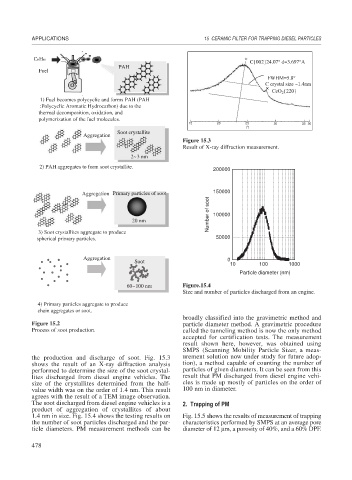Page 506 - Book Hosokawa Nanoparticle Technology Handbook
P. 506
APPLICATIONS 15 CERAMIC FILTER FOR TRAPPING DIESEL PARTICLES
CnHm
C{002}24.07° d=3.697°A
PAH
PAH
Fuel
FWHM=5.8°
C crystal size ~1.4nm
CeO {220}
2
1) Fuel becomes polycyclic and forms PAH (PAH
:Polycyclic Aromatic Hydrocarbon) due to the
thermal decomposition, oxidation, and
polymerization of the fuel molecules.
15 20 25 30 35 36
(°)
Soot crystallite
Soot crystallite
Aggregation
Figure 15.3
Result of X-ray diffraction measurement.
2~3 nm
2) PAH aggregates to form soot crystallite.
200000
Primary particles of soot
Aggregation Primary particles of soot 150000
Number of soot 100000
20 nm
3) Soot crystallites aggregate to produce
spherical primary particles. 50000
Aggregation 0
Soot
Soot
10 100 1000
Particle diameter (nm)
60~100 nm Figure.15.4
Size and number of particles discharged from an engine.
4) Primary particles aggregate to produce
chain aggregates or soot.
broadly classified into the gravimetric method and
Figure 15.2 particle diameter method. A gravimetric procedure
Process of soot production. called the tunneling method is now the only method
accepted for certification tests. The measurement
result shown here, however, was obtained using
SMPS (Scanning Mobility Particle Sizer, a meas-
the production and discharge of soot. Fig. 15.3 urement solution now under study for future adop-
shows the result of an X-ray diffraction analysis tion), a method capable of counting the number of
performed to determine the size of the soot crystal- particles of given diameters. It can be seen from this
lites discharged from diesel engine vehicles. The result that PM discharged from diesel engine vehi-
size of the crystallites determined from the half- cles is made up mostly of particles on the order of
value width was on the order of 1.4 nm. This result 100 nm in diameter.
agrees with the result of a TEM image observation.
The soot discharged from diesel engine vehicles is a 2. Trapping of PM
product of aggregation of crystallites of about
1.4 nm in size. Fig. 15.4 shows the testing results on Fig. 15.5 shows the results of measurement of trapping
the number of soot particles discharged and the par- characteristics performed by SMPS at an average pore
ticle diameters. PM measurement methods can be diameter of 12 m, a porosity of 40%, and a 60% DPF.
478

